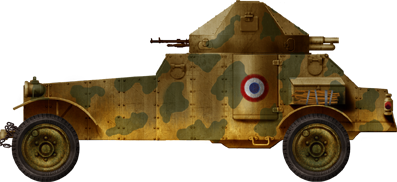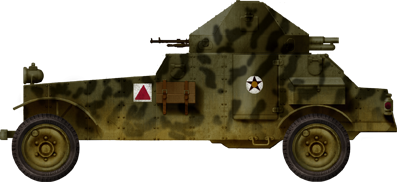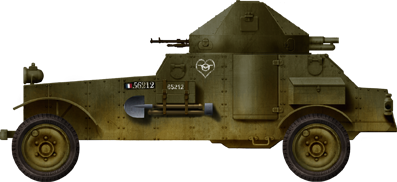Improperly called "White"
By 1929 nearly all French armored cars and most tanks were dating from WWI. On the most used models was the White, based on a US built truck chassis and "dressed" by coachbuilder, turned armored body maker, firm Ségur & Lorfeuvre in 1917-18. More than twenty years after their production the chassis was considered worn-out but the body was still in almost pristine condition. In 1927-28 it was decided to transplant these bodies on a brand new, modernized chassis. Laffly was approached by the army for the task, already known for its LC2 lorry in service. It was a 4x2, with a rear axle resting on double wheels. 2.4 tons rested on the front axle and 3.8 on the rear one, suspended on leaf springs and pneumatic tires. So when the conversion started (the decision was taken in 1929) with a first prototype in 1931, the vehicles were in practice Laffly chassis with original S&L bodies, and the "White" name was only kept for tracing back their origins.Design
The original body was assembled from sheets of rolled steel with an armor thickness of 7 mm (0.3 in), which were fastened to the frame using bolts and rivets. In the front section, wrapped in a boxy hood, was the Laffly 50 hp gasoline engine, with a fuel tank, oil tank, engine cooling system and a portion of transmission assemblies. The engine torque was distributed by a manual transmission, four speeds forward and two reverse. There was from the start a full reverse gear allowing all four forward gears to also act as reverse gears. To ensure a constant flow of air, the radiator was adorned with triple-blind, angled fixed plates vents and an upper movable lid. Engine access was made easier by large removable panels on the sides of the hood.In the driver compartment, the driver sat on the left side and his assistant on the right, also serving a second control station located in the rear of the chassis for reverse march. The fighting compartment occupied the whole aft. To increase its internal volume, the engineers completed near semicircular sidewalls, equivalent to the width of the turret base. The turret was symmetrical, of riveted construction and relatively complex shape with two hatches on the roof through which the vehicle commander and gunner side by side, could monitor their environment. In addition, side sight openings were added. The crew accessed the vehicle through side doors, made of large individual armor plates. The left opened toward the stern, and right towards the bow. Tool boxes, pickaxes, shovels and spare parts were fastened to the sides.
The armament comprised a single short barrel 37 mm (1.46 in) Puteaux SA18 gun, and a single 7.5 mm (0.295 in) FM 24/29 on the opposite side of the turret. Ammunition comprised 164 rounds (92 HE and 72 AP for the 37 mm/1.46 in) and 5500 rounds (including 288 armor-piercing tracers). In addition a spare 7.5 mm (0.295 in) infantry FM was carried, which could be installed on the fork mounts located on the left side of the turret frontal panel, possibly for AA protection although the turret design was ill-suited for this. Both drivers had closed armored covers the front and rear of the chassis for observation and four semicircular ports in the sides of the driving compartment. Electrical equipment included a 6 volt battery, a large removable headlamp was fastened to the brackets on the radiator shutter. A pair of smaller headlights mounted on the hood front corners and a third light located on the left rear wing of the hull, removable.
Conversion and active service
The first conversions were performed in 1931 and trials followed. An order was issued after positive results for the conversion of 60 vehicles. But shortly after, a second order was issued in 1932-1934. New designation was Laffly 50AM or AMD White-Laffly, AMD standing for "Auto-Mitrailleuse de Découverte" (reconnaissance armored car), for the cavalry. However, their age began to tell during the thirties and over the next five years half of these vehicles were sent to the colonies. A small contingent was sent to China, to reinforce the French garrison in Shanghai and later served in Indochina. As of May 1940, 67 were still in service, including 28 to 32 in Algeria and Tunisia, 13 in Metropolitan France with the 4e GRDI (intelligence group attached to 15e DIM), 6 to 10 in Indochina and 12 in Lebanon.Since only a handful were present in France, their actions during the 1940 May-June campaign went almost unnoticed. These were later captured and briefly used to train personnel of the Wehrmacht. All the others remained submitted to various local colonial administrations, but for the African ones, their career was shortened in November 1943 as they were withdrawn with the perspective for the newly formed 1st Free French Army to receive brand new US M8s instead.
Links & references
GBM, Histoire & Collection, about WW2 French tanksOn Wharwheels.net (pdf)
On Chars-Français.net (in Fr)
Laffly AMD 50 specifications |
|
| Dimensions | 5.50x 2.30x 2.60 m (11.48x 5.24x 5.67 ft) |
| Total weight, battle ready | 6.5 tons |
| Crew | 4 (driver, co-driver, commander, gunner) |
| Propulsion | Laffly 4-cyl 3670 cc, 50 hp |
| Top speed | 65 km/h road (50 mph) |
| Suspensions | 2x4 dependent leaf-springs |
| Range/fuel capacity | 300 km (186 mi)/120 L |
| Armament | Main: 37 mm (1.46 in) Puteaux SA18 gun
Secondary: Châtellerault M1931 7.5 mm (0.29 in) machine-gun |
| Armor (max) | 35 mm (1.38 in) |
| Total production | 98 conversions |

White-Laffly AMD 50 in colonial service.

Laffly AMD 50 of an Algerian or Moroccan platoon.

Laffly 50AM in France with the 4th GDI, May 1940.

WW2 Tanks




























WW2 tanks posters

All Tiger tanks liveries.

Panther liveries and variants

WW2 Armour - All tanks











Tanks aces and single tanks series

Find more there

Museums, Movies, Books & Games
The Tanks and Armor in pop culture
Tanks and armored vehicles in general are only really grasped when seen first person: The mass, the scale, it's all there. Explore also the way tanks were covered in the movie industry, in books and in video games.Movies:
Best tanks movie on warhistoryonline.com
On imdb.com
On bestsimilar.com/
miltours.com
liveabout.com/
watchmojo.com
Video Games:
pcgamesn.com
historyhit.com
levvvel.com
vg247.com/best-tank-games
mmobomb.com/
alienwarearena.com

